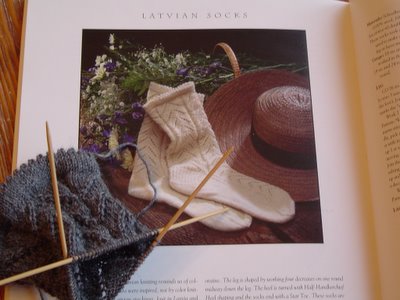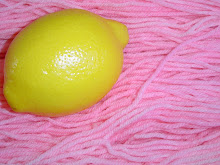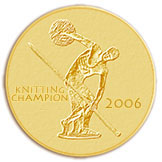There are banks with less security than some toys

The wrapping paper bits and bows have all been gathered up. The turkey has been eaten (or is bagged for reincarnation as sandwiches and chili). The batteries are still holding out and those infernal twisties that toy companies now use to secure the toy to the packaging (you know, the minimum of 385 per toy so you just keep untwisting and untwisting while your kid hops up and down asking, "Is it ready? Can I have it yet?" and by the time you get the toy freed from the highly secure environment it was packaged in, your kid has out grown the toy) have been thrown away in a trash can the cat will never find. We made it through another wonderful Christmas here and while it was great, it was also exhausting and I'm glad that its over.
I started another pair of socks. These are the Latvian Socks from Folk Socks and I'm knitting them with KnitPicks Essential Sock Yarn in the charcoal or dark grey color (I can't remember what the color is called off the top of my head). They have this pretty little picot hem at the top instead of ribbing and then switch to a simple lace pattern. This book is also written by Nancy Bush and it looks like she holds my hand through the heel turn in this one too. I do have a question for those of you that knit socks from the top down: How do you know how long to make the foot? She says to start the toe shaping when its 2 inches or so less than the desired length and I don't know how long the desired length is. I could measure my foot, but the sock is stretchy and how do I measure how much the sock will stretch? Do I try the sock on? Should I not worry about it right now and just keep knitting on faith and hope that tiny sock knitting mice (who would never eat the sock, but only help to knit it) will leave a note one night?










5 Comments:
Merry Christmas, Melanie! I carefully try my sock on and when the end of the knitting reaches across the toe joints between the big toe and the 2nd toe, I start the toe decreases. Also, I much prefer the German Round Toe over the classic wedge toe - much more comfortable.
I keep a "foot" journal of the people I knit socks for. To do this, I take a large piece of paper, place it on the floor, have the intended victim stand barefooted on it, and then trace all around the perimeter of the foot - make sure you also run the pencil BETWEEN the great toe and the second toe! Then you can measure the total length from heel to tip of toe or just to where the sock toe would begin (between the two toes mark). Also, I measure and record other vital foot data - ankle circumference/instep circumference/heel height from floor to top of heel/yarn perference/color preference and anything else I might need. I keep all these pages in a separate notebook for whenever I knit them socks. Clear as mud? Kate/Massachusetts
Those are going to be beautiful Melanie!
As for your question. Measure from your heal to the tip of your big toe. This will give you the total length. When measuring the sock in progress, lay flat and measure from the back of the heel, when you are about two inches shy of your foot measurement, this is when you will begin your decreases. I have always found this method to work well in getting just the right length for the foot without it being loose. The sock will have some give, but usually this isn't a problem. Of course I do try on my sock as I knit as well.
What I do is try my socks on - I knit using 2 circs so this is easy to do. When the foot is up to the point where my big toe meets my foot, that's when I know to start working the toe part - I like to leave the last 2 inches for the toe portion. I also measure my feet from heel to toe, and then subtract 2 inches from that and the remainder is how much I have to knit before starting the decrease.
Hi Melanie - here's a link to the yahoo group knitalong devoted to the Folk Solks book (maybe you already knew about it, but just in case):
http://groups.yahoo.com/group/Folk_Sock_Knitalong/
This comments section has some great sock-sizing tips from your readers!
Those are such pretty socks. And I agree with the others about when to start the toe.
Post a Comment
<< Home